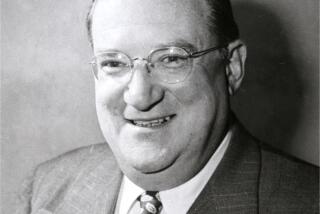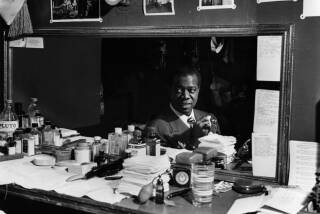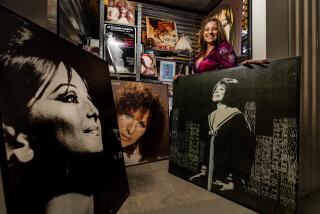Wonderful World of Satchmo’s Archive
- Share via
NEW YORK — Louis Armstrong’s gravelly laughter was contagious as it spilled from the speakers, filling a small conference room and drifting down the hallway.
Dozens of people giggled and howled as they listened to the recording at the Queens College library--the late jazz king was being badgered by his wife about giving the wrong date during a home recording session, then trying to correct it only to get it wrong again.
It’s one of many private moments that Armstrong captured in home recordings and now can be heard at the little-known Louis Armstrong House and Archive, the largest collection of Armstrong memorabilia in the country.
“Louis recorded everything. He had a trunk custom-made with recording equipment so he could take it with him on the road. It was like a 1950s Walkman,” said archive director Michael Cogswell. “Sometimes he would turn it on and leave it running for hours at a time.”
The result: More than 650 tapes--each more than four hours long--that give a glimpse of Armstrong’s wonderful world: his relationships with family and friends, and his love of singing and playing the trumpet.
The recordings, along with Armstrong’s home and its contents, were left to the New York City Department of Cultural Affairs by Armstrong’s wife, Lucille, after her death in 1983. Armstrong died in 1971.
The house is scheduled to open to visitors on July 4, 2000--thought to be the 100th anniversary of Armstrong’s birth. (The archive will still be housed at the library.)
Armstrong’s belongings sat from 1983 to 1987 in the vacant house before they were extensively examined and the extent of the treasure trove was known.
“The Armstrong estate knew what was in the house. The conservators had told us, ‘You have got to get that stuff out of the house,’ ” Cogswell said. “When we brought the stuff to the college, we found what the recordings were all about.”
The archive, operated by the college, is copying every one of Armstrong’s original recordings, which have become fragile over time. Because of the sheer volume of the recordings, the process is time-consuming and nobody has documented every word.
But gems have already been uncovered, such as a recording that Armstrong made in a hotel room in 1960 that features him playing the trumpet along with a 1927 recording of himself with the legendary King Oliver.
And perhaps the greatest revelation about Armstrong is “what you saw is what you got.”
“The same person who was visiting with his buddies in the house in Corona (a section of Queens) was the same one who was on stage,” Cogswell said.
That good nature made Armstrong an ambassador of goodwill, said First Lady Hillary Rodham Clinton during a recent visit to the archive to promote her Save America’s Treasures tour.
“He was not only an American ambassador overseas,” she said. “He was an ambassador of another kind . . . between and among the races.”
The archive is financed by public and private donations, and the house has been declared a national landmark.
Visitors to the archive are treated to a history lesson of Armstrong’s life. According to Cogswell, Armstrong was called satchel mouth as a child because of his big, toothy smile. During a trip to London in 1932, a magazine editor shortened the nickname when he greeted Armstrong with “Hello, Satchmo.” Armstrong liked the name so much he used it as an album title.
Years of blowing the horn took their toll on Armstrong, who blew out his lip during a tour in Europe. After that, he used a special lip cream made for him by a pharmacist.
Four years before his death, Armstrong recorded “What a Wonderful World,” but it was far from a success. It wasn’t until the Robin Williams movie “Good Morning Vietnam” in 1987--16 years after Armstrong’s death--that the song became a Top 40 hit.
Interest in Armstrong has grown in recent years. More than 1,200 visitors went to the archive last year, and Cogswell gets five to 10 e-mails a day.
Bernice and Jim Green from suburban Long Island sat in a small room off the main library during a recent presentation at the archives, hanging on every word as Armstrong’s trademark scratchy voice blended with the static from the old recording.
“It’s like going home--listening to him as I was growing up,” Bernice Green said.
More to Read
Sign up for The Wild
We’ll help you find the best places to hike, bike and run, as well as the perfect silent spots for meditation and yoga.
You may occasionally receive promotional content from the Los Angeles Times.






